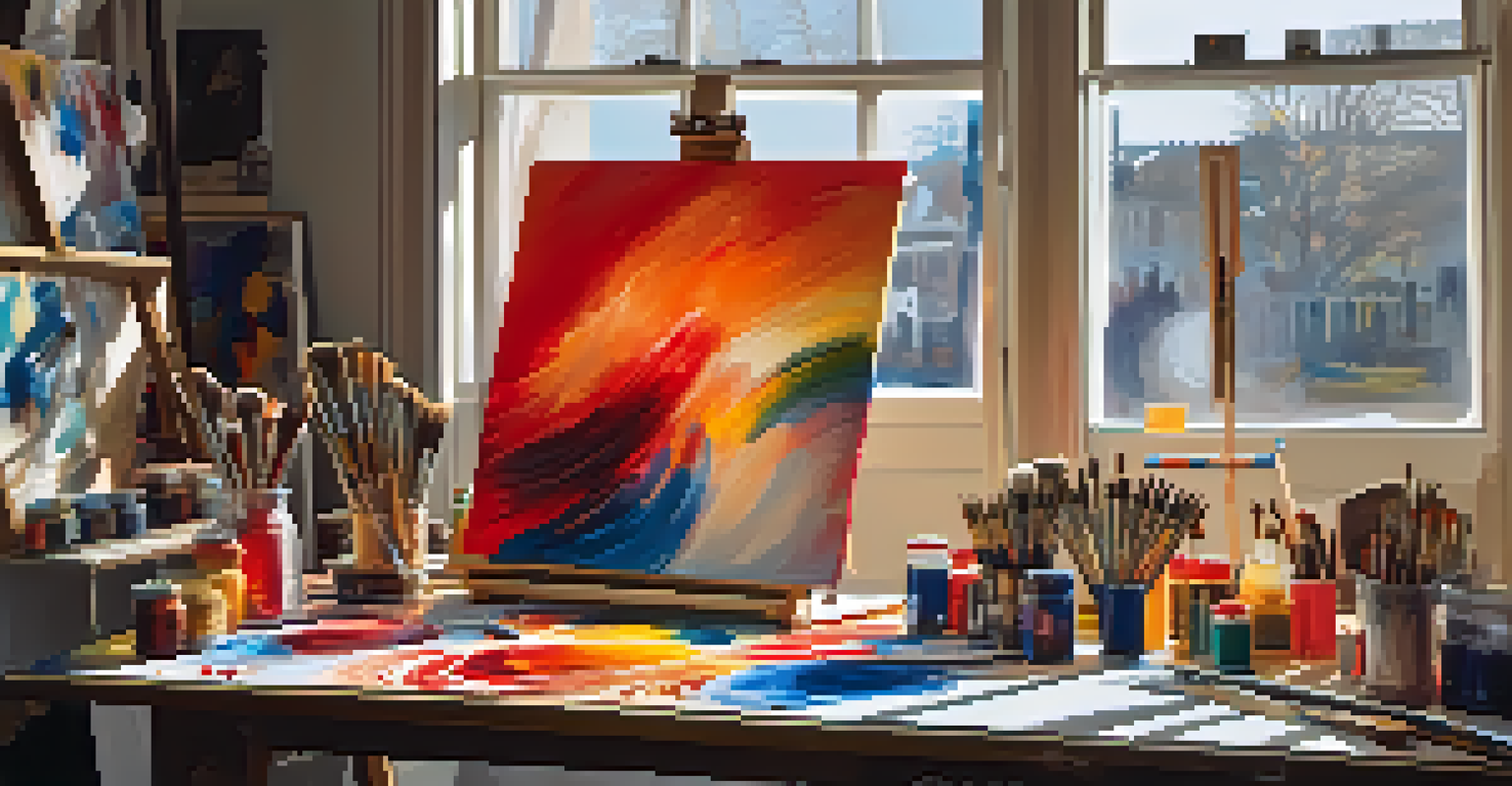Evaluating Art Through Psychological Theories and Perspectives

Understanding Psychological Theories in Art Evaluation
Psychological theories provide a framework for understanding how we interpret art. By examining our emotional and cognitive responses, we can better appreciate the depth of creative expression. These theories help decode the artist's intent and the viewer's experience, bridging the gap between creator and observer.
Art is the most beautiful of all lies.
For instance, theories like Gestalt psychology emphasize how our brains group visual elements into meaningful wholes. This perspective allows us to see beyond individual strokes and colors, revealing patterns that evoke emotional responses. Appreciating art then becomes not just about aesthetics but also about understanding the psychological mechanisms at play.
Furthermore, psychoanalytic theory delves into the subconscious motivations behind both creation and appreciation of art. It suggests that our personal experiences and hidden emotions significantly influence how we interpret artistic works. This intersection of psychology and art opens up a rich dialogue about meaning and intention.
The Role of Emotion in Art Interpretation
Emotion plays a crucial role in how we perceive and evaluate art. When we engage with a piece, our feelings can amplify its impact, making the experience personal and transformative. For example, a painting depicting sorrow might evoke feelings of empathy or nostalgia in the viewer, highlighting the emotional connection art can foster.

Psychological theories, such as the James-Lange theory, suggest that our physical reactions to art—like chills or tears—are tied to our emotional experiences. This underscores the idea that art not only represents emotions but can also elicit them. Such responses are a testament to art’s power to resonate deeply with our inner selves.
Psychology Enhances Art Appreciation
Understanding psychological theories helps us decode the emotional and cognitive responses that shape our interpretation of art.
Moreover, understanding the emotional triggers in art can help us evaluate its effectiveness. A well-executed piece that successfully communicates emotion may leave a lasting impression, influencing our interpretation and appreciation. This emotional engagement can often lead to a more profound understanding of the artwork.
Cognitive Approaches to Understanding Art
Cognitive psychology offers insights into how our brains process and understand art. This perspective focuses on perception, memory, and thought processes, revealing how we make sense of visual stimuli. For instance, our prior knowledge and experiences shape how we interpret symbols and themes in a work of art.
The painting is a poem without words.
Consider how familiarity with certain artistic styles or historical contexts can enhance our understanding of a piece. When we recognize a reference or technique, it enriches our appreciation and allows us to engage more deeply. This cognitive engagement transforms art from a mere visual experience into a complex interaction.
Additionally, cognitive theories suggest that our brain actively organizes visual information, helping us to navigate and interpret art. This mental process can influence our preferences and judgments, leading us to favor works that resonate with our cognitive styles. Understanding these cognitive processes can elevate our art evaluation skills and deepen our overall experience.
Cultural Influences on Artistic Perception
Culture significantly shapes how we perceive and interpret art. Different cultural backgrounds bring unique perspectives, influencing our interpretations and emotional responses. For instance, a piece of art that resonates deeply in one culture may be met with confusion or indifference in another, showcasing the diversity of artistic appreciation.
Psychological research highlights how cultural norms and values inform our understanding of aesthetics. This means that the same artwork can evoke various interpretations based on the viewer's cultural lens. Recognizing this cultural context is essential in evaluating art meaningfully and respectfully.
Emotion Deepens Art Engagement
Emotional responses to art play a crucial role in how we perceive and evaluate artistic works, fostering personal connections.
Moreover, as globalization connects cultures, our exposure to diverse artistic expressions broadens our horizons. This fusion of influences can lead to richer interpretations and a more inclusive appreciation of art from around the world. Embracing cultural diversity in art evaluation fosters empathy and understanding among different perspectives.
The Impact of Personal Experience on Art Evaluation
Each individual's personal experiences play a vital role in how they evaluate art. Our backgrounds, memories, and emotions shape our interpretations, making art a deeply personal journey. For instance, someone who has experienced loss may connect with a piece that explores themes of grief more intensely than someone who hasn’t.
Psychological theories like constructivism suggest that we actively construct meaning based on our experiences. This means that no two viewers will interpret a piece of art in the same way, leading to a rich tapestry of perspectives. This subjectivity is what makes art so intriguing and multifaceted.
Furthermore, acknowledging the influence of personal experiences can enhance our appreciation of diverse viewpoints in art. It encourages open dialogue, allowing us to explore and learn from others' interpretations. This collective exploration enriches our understanding of art as a shared human experience.
The Role of Art in Psychological Healing
Art therapy has emerged as a powerful tool in psychological healing, highlighting the therapeutic benefits of artistic expression. This approach allows individuals to explore their emotions and experiences creatively, facilitating healing and self-discovery. For many, creating or engaging with art becomes a safe space for processing complex feelings.
Psychological theories support the notion that artistic expression can lead to emotional release and catharsis. This process often helps individuals articulate feelings they might struggle to express verbally. By evaluating art through this lens, we can appreciate its role not just as a form of expression but as a vital component of mental well-being.
Cultural Context Influences Art Views
Cultural backgrounds significantly shape our interpretations of art, highlighting the diversity of artistic appreciation across different societies.
Moreover, understanding art's therapeutic potential opens up conversations about its value beyond traditional evaluation. It encourages us to view art as a tool for connection, healing, and growth, reinforcing the idea that art serves a purpose far beyond aesthetics. This perspective enriches our appreciation of artistic endeavors in various contexts.
Integrating Psychological Perspectives in Art Education
Incorporating psychological perspectives into art education can enhance both teaching and learning experiences. By understanding how students perceive and engage with art, educators can tailor their approaches to foster deeper connections. This integration encourages critical thinking and personal interpretation, which are essential skills in art appreciation.
Psychological theories can inform curriculum design, helping educators create environments that nurture emotional and cognitive engagement. For example, lessons that explore the emotional impact of specific techniques or styles can lead to richer discussions about intent and interpretation. This approach empowers students to articulate their experiences and responses to art.

Additionally, integrating psychology into art education promotes inclusivity, allowing diverse perspectives to flourish. By acknowledging the varied backgrounds and experiences of students, educators can create a space where all voices are valued. This inclusive approach not only enhances learning but also cultivates a deeper appreciation for the diverse world of art.